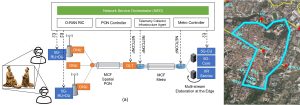A groundbreaking trial in Europe shows how future networks can deliver immersive technology while saving energy.
The world is now on the edge of a new digital frontier. Augmented reality (AR) and virtual reality (VR) services, once limited to gaming and entertainment, are rapidly evolving into powerful tools for education, healthcare, manufacturing, and even cultural preservation. Imagine a student wearing a headset to explore the ruins of ancient Rome, a surgeon using virtual overlays to perform remote surgery, or an architect walking a client through a digital replica of a yet-to-be-built skyscraper.
These experiences require more than just fast internet. You need ultra-low latency, massive bandwidth, and reliable connectivity while reducing energy consumption. This combination is not an easy challenge. Current communication networks are primarily designed for smartphones and streaming video and struggle to scale efficiently.
However, recent efforts in Europe led by the SEASON project offer a glimpse of how next-generation networks can meet the demands of immersive technology. In the Italian city of L’Aquila, researchers and carriers conducted the world’s first field test of a system combining spatial passive optical networks (PON), multicore fiber (MCF), open radio access networks (O-RAN), and edge computing. The results show that through intelligent orchestration of resources, immersive services can be delivered with seamless quality and energy savings of up to 11% are possible. This achievement is important not only for AR/VR, but also for the future of 5G, 6G, and sustainable digital infrastructure.
What makes this breakthrough possible
To understand the importance of this exam, we need to break down its technical underpinnings into easy-to-understand terms.
Multicore fiber and space division multiplexing
Traditional fiber optic cables transmit light through a single glass core. Multicore fiber (MCF) contains multiple cores within the same cladding, allowing multiple optical paths to coexist without interference. This approach, known as space division multiplexing (SDM), dramatically increases capacity without installing additional cables. This is similar to replacing a single-lane highway with a multi-lane highway. More traffic can flow without expanding the road footprint.
Passive optical network (PON)
PON is widely used in fiber-to-the-home deployments, where a single optical line terminal (OLT) at the provider side serves multiple users through a passive splitter. The innovation here is a spatial PON that can dynamically activate or deactivate lanes within a multicore fiber. As user demand increases, more “lanes” open up. When demand drops, unused lanes are turned off to save power.

Open RAN and distributed units
In mobile networks, wireless access has traditionally been provided through proprietary, tightly integrated equipment. Open RAN (O-RAN) divides this model into interoperable components, such as radio units (RUs) and distributed units (DUs), managed by intelligent controllers. By monitoring real-time traffic, the system can activate additional small cells only when needed. For example, when multiple VR headsets come online at the same time.
edge computing
Instead of routing all your data to distant data centers, edge computing brings processing power closer to your users. For AR/VR, this is extremely important. Even a 1-second delay can break immersion. In the trial, VR applications were hosted at the edge, enabling real-time rendering with minimal latency.
Orchestration and closed-loop control
The real magic comes from the orchestration that coordinates all these moving parts. The trial used a network service orchestrator (NSO) to manage the PON controller, O-RAN intelligent controller, metro transport, and telemetry systems. We created a closed-loop system that automatically makes decisions based on live monitoring and adapts to demand within seconds.
L’Aquila trial: A glimpse of tomorrow’s networks
The L’Aquila experiment was not conducted in a laboratory, but on an actual urban multicore fiber ring approximately 6 km long, connecting optical, wireless, and edge infrastructure (see Figure 1 below). Its contents are as follows:
Baseline setup: One radio unit (RU) and one PON port supported VR user streaming content from a virtual museum app. Scale up: When a second user joins, traffic monitoring detects an increase. Within seconds, the new RU/DU was activated, opening additional spatial lanes in the fiber and configuring additional PON ports. Energy efficiency: Power consumption increased slightly from 175 W to 197 W, but resources were automatically deactivated when traffic subsided and returned to baseline. This flexibility resulted in 11% energy savings compared to keeping everything running at full capacity all the time. Service Continuity: Users experienced seamless VR streaming with no quality loss during network reconfiguration.
The orchestration process from traffic detection to resource reallocation took less than 5 seconds. This is faster than reloading a web page on a slow connection.
Why energy efficiency matters
At first glance, saving 22W may not sound like a big deal. But scale matters. In dense urban environments where thousands of small cells and optical nodes may be deployed, even small savings per unit can lead to significant reductions in power consumption and carbon emissions.
Telecommunications networks already account for a large share of global energy use. As 5G rolls out and 6G is just around the corner, the challenges are clear. How can we deliver exponentially more data while reducing exponentially increasing power consumption?
As this trial demonstrates, the answer lies in intelligent, demand-driven resource management. Instead of building a large, always-on infrastructure, networks can become adaptive organisms that power up when needed and power down when idle.
AR/VR as a test case – and beyond
AR and VR are the perfect stress tests for next-generation networks. Its requirements are more stringent than those of most applications today, pushing infrastructure to its limits. If your system can support seamless AR/VR, it can handle just about anything else, including:
Smart cities with real-time sensor integration. Self-driving cars that require low-latency coordination. Telemedicine through remote diagnosis and remote surgery. Industrial automation, where machines work together through networks.

So while L’Aquila’s trial focused on immersive applications, its implications are much broader. This shows that scalable and sustainable connectivity for the digital society of the future is within reach.
Core collaboration
This exam is the result of a collaboration between universities, carriers and technology providers across Europe, including CNIT, University of L’Aquila, UPC, Telefonica, TIM, FiberCop, WestAquila and Accelleran. Funded under the EU SEASON project, it exemplifies the European approach to innovation, combining academic research, industrial expertise and real-world deployment.
Such partnerships are essential to addressing the complexities of modern networks. No single player, even the largest carrier, can master all the moving parts on its own. This project brought together expertise to bridge photonics, wireless access, edge computing, and orchestration into an integrated solution.
Towards 6G
While 5G is still being rolled out around the world, research on 6G is already well underway. If 5G is about connecting everything, 6G is about sensing, intelligence, and sustainability. The network not only transmits data, but also gathers context, actively adapts, and integrates with satellite and non-terrestrial systems.
The principles demonstrated at L’Aquila – multicore fiber, spatial multiplexing, dynamic orchestration, and energy-aware design – could play a pivotal role. These are fully aligned with 6G’s vision of a green, adaptive, and human-centric network.
Conclusion: Towards sustainable immersion
The field trial in L’Aquila is a milestone. It is the first real-world demonstration that immersive technologies such as AR/VR can be delivered seamlessly and sustainably through an integrated optical-wireless edge architecture. By dynamically scaling resources, the system achieved both high performance and meaningful energy savings.
Innovations like this will be essential as immersive technology moves from niche to mainstream and global connectivity demand soars. They show that the Internet of the future has the potential to not only be faster and richer, but also smarter and greener. In other words, the networks that power our digital future don’t just carry data, they also carry services.
This article will also be published in the quarterly magazine issue 24.
Source link

